Pressure Control Algorithm Based on Adaptive Fuzzy PID with Compensation Correction for the Tractor Electronic Hydraulic Hitch
Abstract
1. Introduction
2. Mathematical Model of the Pressure Control System for the Tractor Electronic Hydraulic Hitch
2.1. Analysis of Kinematics of the Tractor Electronic Hydraulic Hitch
2.2. The Dynamic Model of the Tractor Electronic Hydraulic Hitch
2.3. Mathematical Model of the Hydraulic System for the Tractor Electronic Hydraulic Hitch
3. Design of the Pressure Control Algorithm
3.1. The Compensation Correction Link
3.2. Design of the Adaptive Fuzzy PID Algorithm
3.2.1. The Adaptive Fuzzy PID Control Algorithm
3.2.2. Control Variable Fuzzification and Membership Function
3.2.3. Adaptive Fuzzy PID Control Rules
- (a)
- When |e| is a large value, to speed up the response of the system, the ∆Kp value should be larger; ∆Ki is often set to 0 to avoid the differential oversaturation caused by the instantaneous increase of the |e| value
- (b)
- When |e| is a medium value, to reduce the overshoot of the system, the values of ∆Kp, and ∆Ki should be smaller and the value of ∆Kd should be appropriate to speed up the response of the system.
- (c)
- When |e| is a small value, to keep the good steady-state performance of the system, ∆Kp and ∆Ki should be set as larger values, and the value of ∆Kd is up to |ec|. When |ec| is small, ∆Kd takes a larger value. When |ec| is large, ∆Kd should take a smaller value to avoid oscillation of the system.
4. Simulation Analysis
5. Field Experimental Results and Discussion
5.1. Field Experimental Scheme
5.2. Analysis of Experimental Results
6. Conclusions
Author Contributions
Funding
Acknowledgments
Conflicts of Interest
References
- Kovačev, I.G.; Košutić, S.; Jejčič, V.; Čopec, K.; Gospodarić, Z.; Pliestić, S. Impact of Electronic-Hydraulic Hitch Control on Rational Exploitation of Tractor in Ploughing. Hrvatski Strojarski i Brodograđevni Inženjerski Savez 2008, 50, 287–294. [Google Scholar]
- Bin, X.; Zhongbin, W.U.; Enrong, M. Development and Prospect of Key Technologies on Agricultural Tractor. Trans. Chin. Soc. Agric Mach. 2018. [Google Scholar] [CrossRef]
- Moreda, G.P.; Muñoz-García, M.A.; Barreiro, P. High voltage electrification of tractor and agricultural machinery—A review. Energ Convers. Manag. 2016, 115, 117–131. [Google Scholar] [CrossRef]
- Borghi, M.; Zardin, B.; Pintore, F.; Belluzzi, F. Energy Savings in the Hydraulic Circuit of Agricultural Tractors. Energy Procedia 2014, 45, 352–361. [Google Scholar] [CrossRef]
- Du, Q.L.; Chen, X.H. Design on Control System for Electro-Hydraulic Hitch Equipment of Tractor. Adv. Mater. Res. 2014, 945–949, 1513–1516. [Google Scholar] [CrossRef]
- Borodani, P.; Colombo, D.; Forestello, M.; Morselli, R.; Turco, P. Robust Control of a New Electro-Hydraulic Pump for Agricultural Tractors. IFAC Proc. Vol. 2011, 44, 2266–2271. [Google Scholar] [CrossRef]
- Han, J.; Xia, C.; Shang, G.; Gao, X. In-field experiment of electro-hydraulic tillage depth draft-position mixed control on tractor. Mater. Sci. Eng. 2017, 274, 12028. [Google Scholar] [CrossRef]
- Li, M.; Zhao, J.; Zhu, Z.; Xie, B.; Mao, E. Fuzzy-PID self-adaptive control method in electro-hydraulic hitch system. Trans. Chin. Soc. Agric. Mach. 2013. [Google Scholar] [CrossRef]
- Mingsheng Li, L.W.J.L. Method study on fuzzy-PID adaptive control of electric-hydraulic hitch system. AIP Conf. Proc. 2017, 1820, 070008. [Google Scholar]
- Zhao, J.; Zhu, Z.; Song, Z.; Zhou, R.; Wang, R.; Mao, E. Proportional Controller for Electro-hydraulic Hitch System in Heavy Tractor. Trans. Chin. Soc. Agric. Mach. 2014, 45, 10–16. [Google Scholar]
- Shafaei, S.M.; Loghavi, M.; Kamgar, S. A practical effort to equip tractor-implement with fuzzy depth and draft control system. Eng. Agric. Environ. Food 2019, 12, 191–203. [Google Scholar] [CrossRef]
- Gupta, C.; Tewari, V.K.; Ashok Kumar, A.; Shrivastava, P. Automatic tractor slip-draft embedded control system. Comput. Electron. Agric. 2019, 165, 104947. [Google Scholar] [CrossRef]
- Jiangxue, B.X.L.Z.; Weiwei, L.H.Z. Fuzzy control algorithm simulation of automatic control of tilling depth for tractor based on slip rate. Trans. Chin. Soc. Agric. Mach. 2012, S1. [Google Scholar] [CrossRef]
- Almaliki, S.; Alimardani, R.; Omid, M. Fuel consumption models of MF285 tractor under various field conditions. Agric. Eng. Int. CIGR J. 2016, 18, 147–158. [Google Scholar]
- Ditzingen, G.B.R.A. Rexroth Bosch Group. In Knowledge Explanation: Hydraulic for Tractor; Bosch Robert AG: Ditzingen, Germany, 2014. [Google Scholar]
- Moitzi, G.; Haas, M.; Wagentristl, H.; Boxberger, J.; Gronauer, A. Energy consumption in cultivating and ploughing with traction improvement system and consideration of the rear furrow wheel-load in ploughing. Soil Tillage Res. 2013, 134, 56–60. [Google Scholar] [CrossRef]
- Petranský, I.; Drabant, Š.; Ďuďák, J.; Žikla, A.; Grman, I.; Jablonický, J. Pressure in the hydraulic system of three point hitch of tractor equiped with electrical and mechanical control. Res. Agric. Eng. 2012, 49, 37–43. [Google Scholar] [CrossRef]
- Tao, Q.; Lee, H.P.; Lim, S.P. Contact mechanics of surfaces with various models of roughness descriptions. Wear 2001, 249, 539–545. [Google Scholar] [CrossRef]
- Schmid, I.C. Interaction of vehicle and terrain results from 10 years research at IKK. J. Terramech. 1995, 32, 3–26. [Google Scholar] [CrossRef]
- Mu, X. Adaptive optimal decoupling control in helicopter rotor concordant loading system. China Mech. Eng. 2007, 18, 2691–2696. [Google Scholar]
- Yoon, J.I. A Study on Force Control of Electric-Hydraulic Load Simulator Using an Online Tuning Quantitative Feedback Theory. In Proceedings of the 2008 International Conference on Control, Automation and Systems, Seoul, Korea, 14–17 October 2008; pp. 2622–2627. [Google Scholar]
- Shang, Y. Nonlinear adaptive torque control of electro-hydraulic load system with external active motion disturbance. Mechatronics 2014, 24, 32–40. [Google Scholar]
- Bin, Y.J.J.Z. Nonlinear Adaptive Robust Force Control of Hydraulic Load Simulator. Chin. J. Aeronaut. 2012, 25, 107–116. [Google Scholar]
- Jiang, Y.; Wang, H.; Qian, Y. Hybrid Compensation Method of Redundant Force for Electrical-hydraulic Loading Simulator. Chin. Hydraul. Amp. Pneum. 2017, 10, 43–48. [Google Scholar]
- Zhang, J.; Zhao, Y.; Yan, H.; Changchun, L.I.; Sun, M.; Mechanical, S.O. Research on compensation and control strategy of redundant force of electro-hydraulic servo load simulator. J. Beijing Jiaotong Univ. 2014, 38, 146–152. [Google Scholar]
- Gang, Y. Electro-hydraulic load systems based on fuzzy PID controller. J. Huazhong Univ. Sci. Technol. 2012, 40, 59–62. [Google Scholar]
- Wang, H.; Wang, D.; Zhang, G. Research of Neural Network PID Control of Aero-Engine; Springer: Berlin/Heidelberg, Germany, 2012; Volume 122, pp. 337–343. [Google Scholar]
- Al-Odienat, A.I.; Al-Lawama, A.A. The advantages of PID fuzzy controllers over the conventional types. Am. J. Appl. Sci. 2008, 5, 653–658. [Google Scholar] [CrossRef]
- Eski, O.; Kuş, Z.A. Control of unmanned agricultural vehicles using neural network-based control system. Neural Comput. Appl. 2019, 31, 583–595. [Google Scholar] [CrossRef]
- Yin, J.; Zhu, D.; Liao, J.; Zhu, G.; Wang, Y.; Zhang, S. Automatic Steering Control Algorithm Based on Compound Fuzzy PID for Rice Transplanter. Appl. Sci. 2019, 9, 2666. [Google Scholar] [CrossRef]
- Soares, F.T.; Cappelli, N.L.; Garcia, A.P.; Umezu, C.K. Fuzzy control applied to an electrical power generation system mounted on tractors for driving of agricultural implements. Eng. Agrícola 2016, 36, 846–857. [Google Scholar] [CrossRef]
- Zhi-Cheng, W.U.; Chen, S.Z.; Yang, L.; Zhang, B. Model of Road Roughness in Time Domain Based on Rational Function. Trans. Beijing Inst. Technol. 2009, 29, 795–798. [Google Scholar]
- Crolla, D.A.; Pearson, G. The response of tractor draught controls to random variations in draught. J. Agric. Eng. Res. 1975, 20, 181–197. [Google Scholar] [CrossRef]
- Bekker, M.G. Introduction to Terrain-Vehicle Systems. Part I: The Terrain. Part II: The Vehicle; Michigan University: Ann Arbor, MI, USA, 1969. [Google Scholar]
- Bekker, M.G. Theory of Land Locomotion; The University of Michigan Press: Ann Arbor, MI, USA, 1956. [Google Scholar]
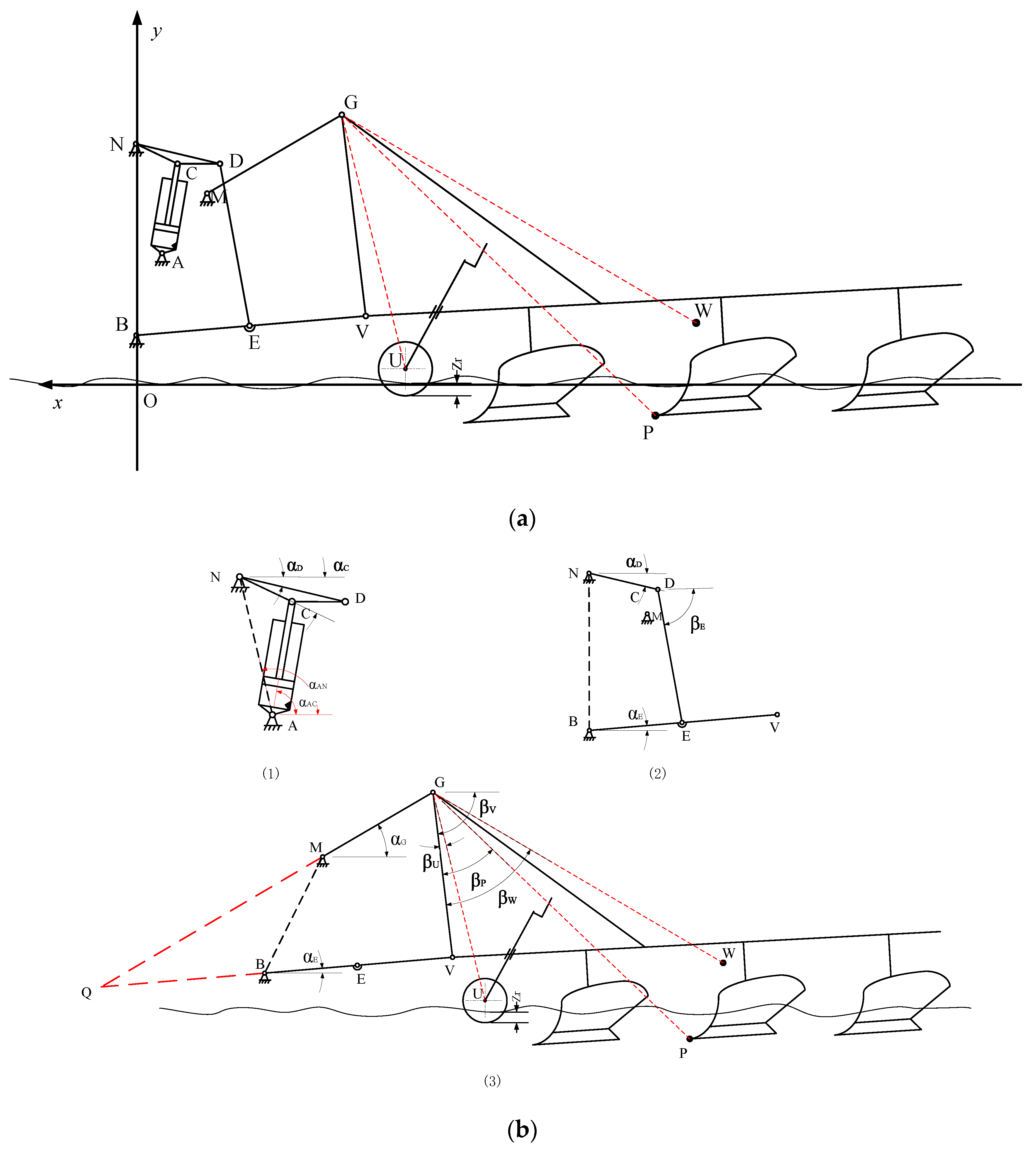

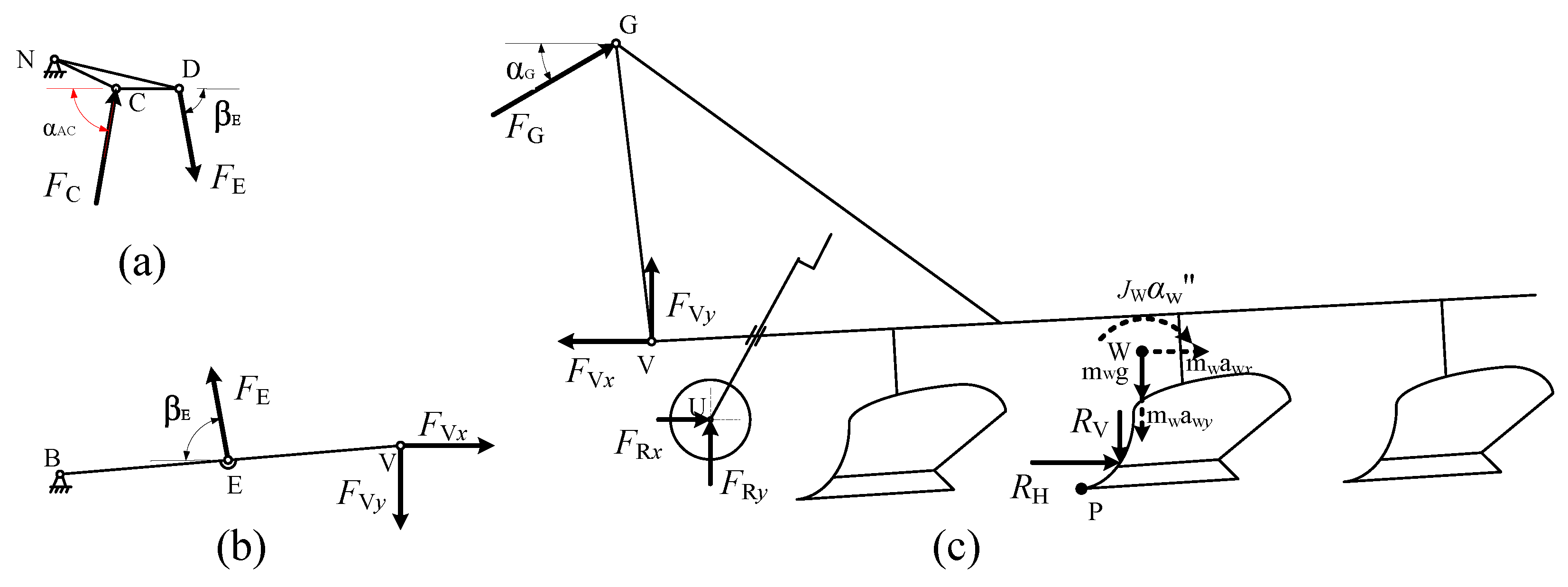




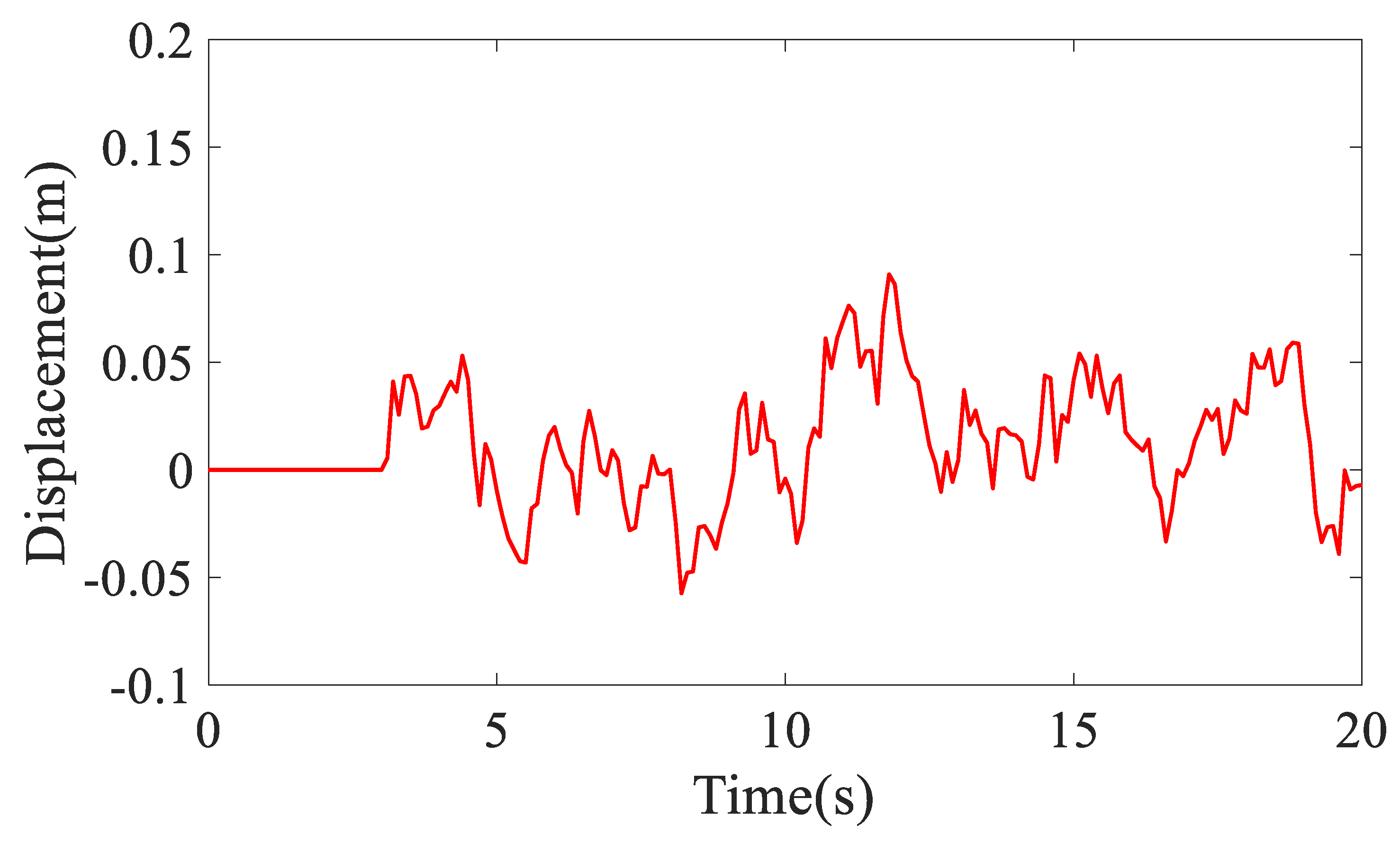
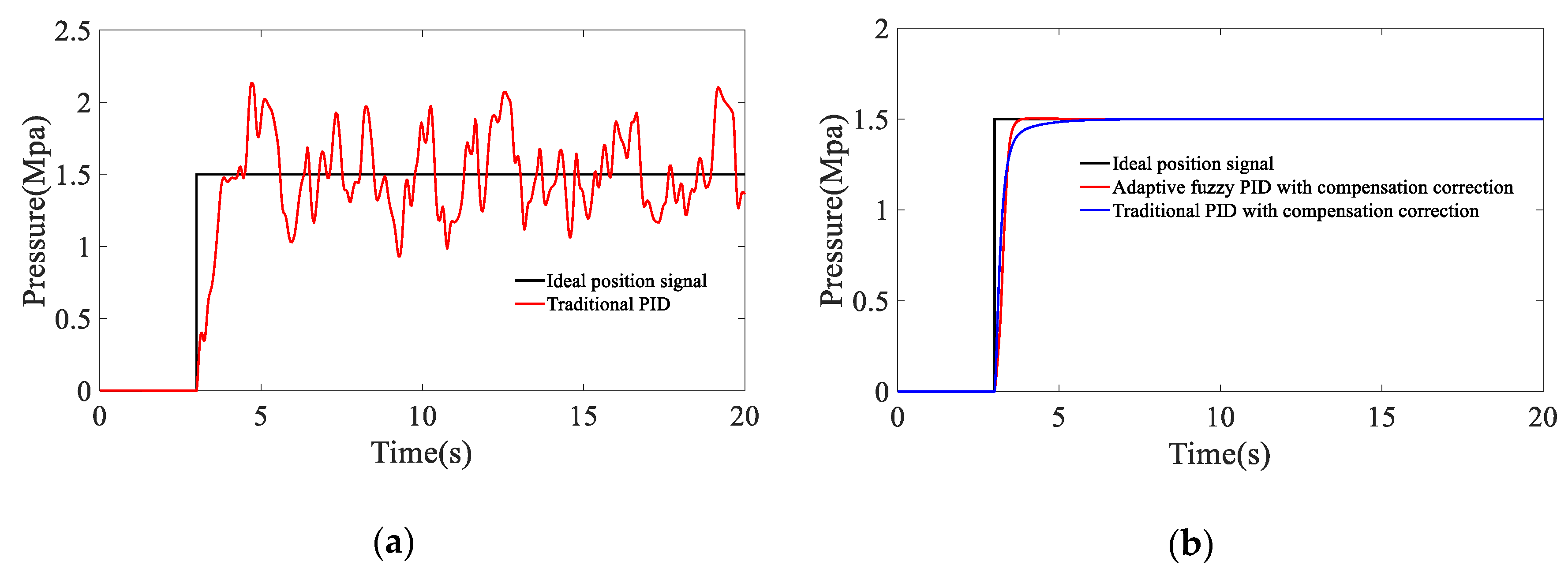
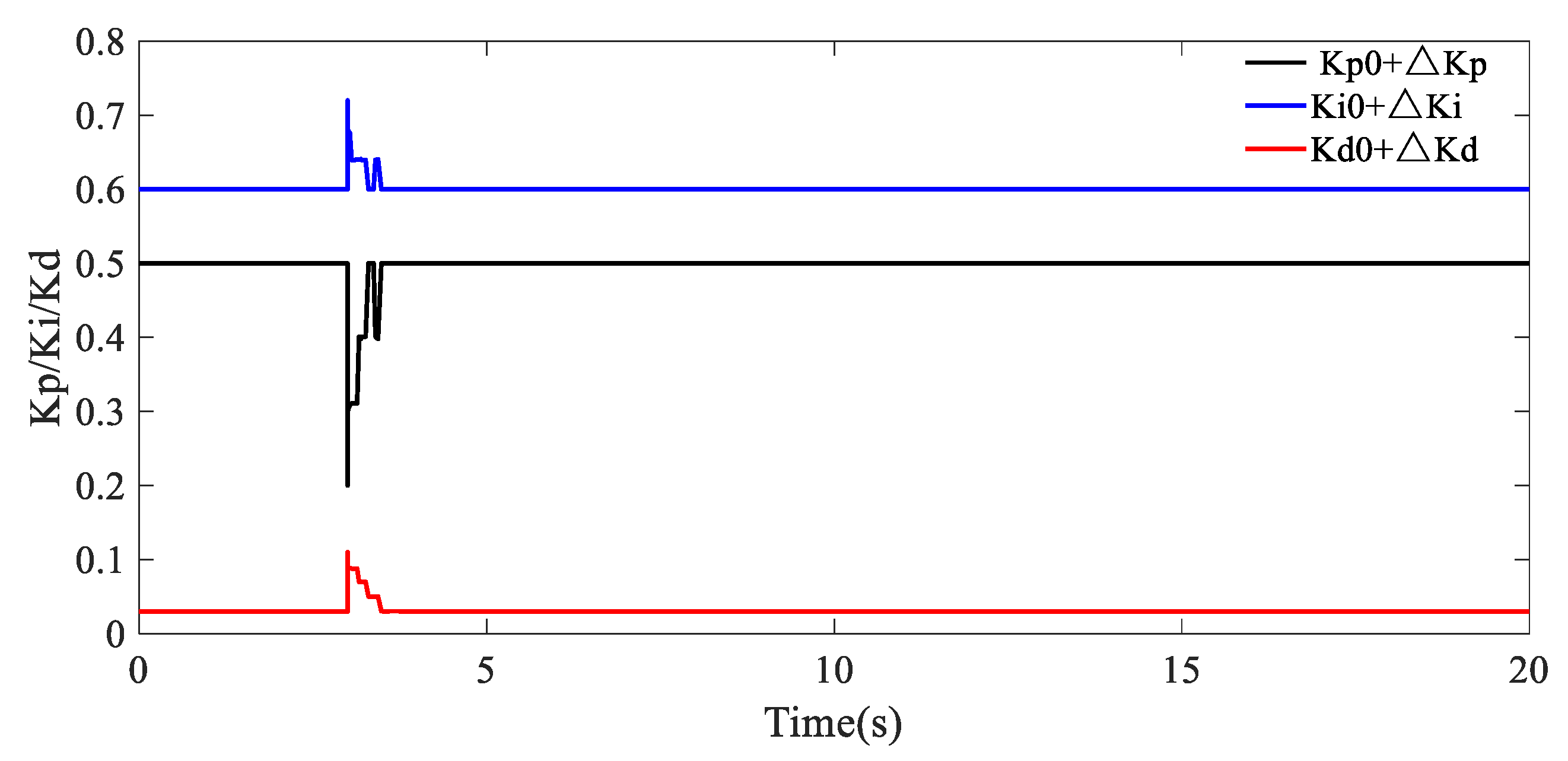
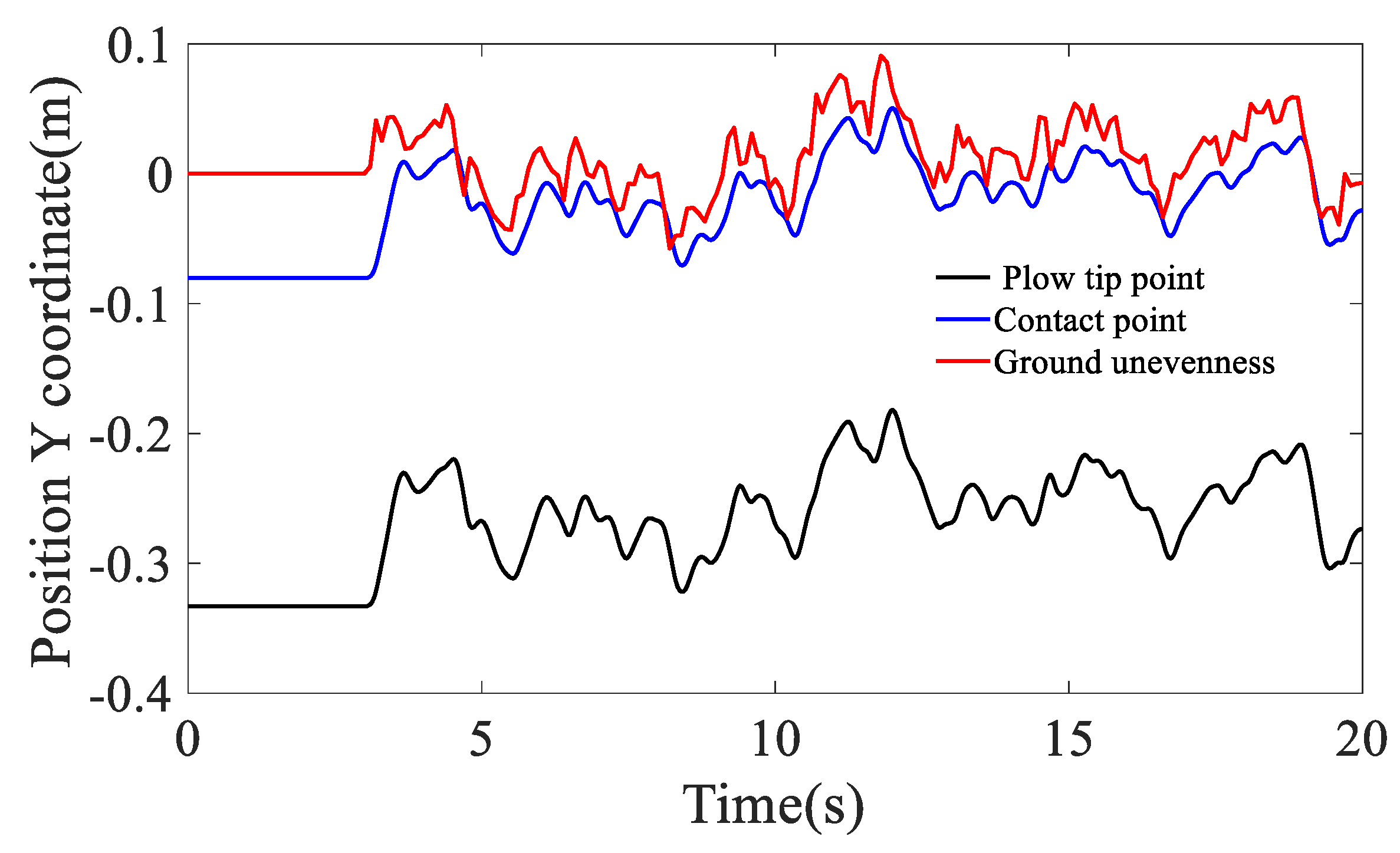
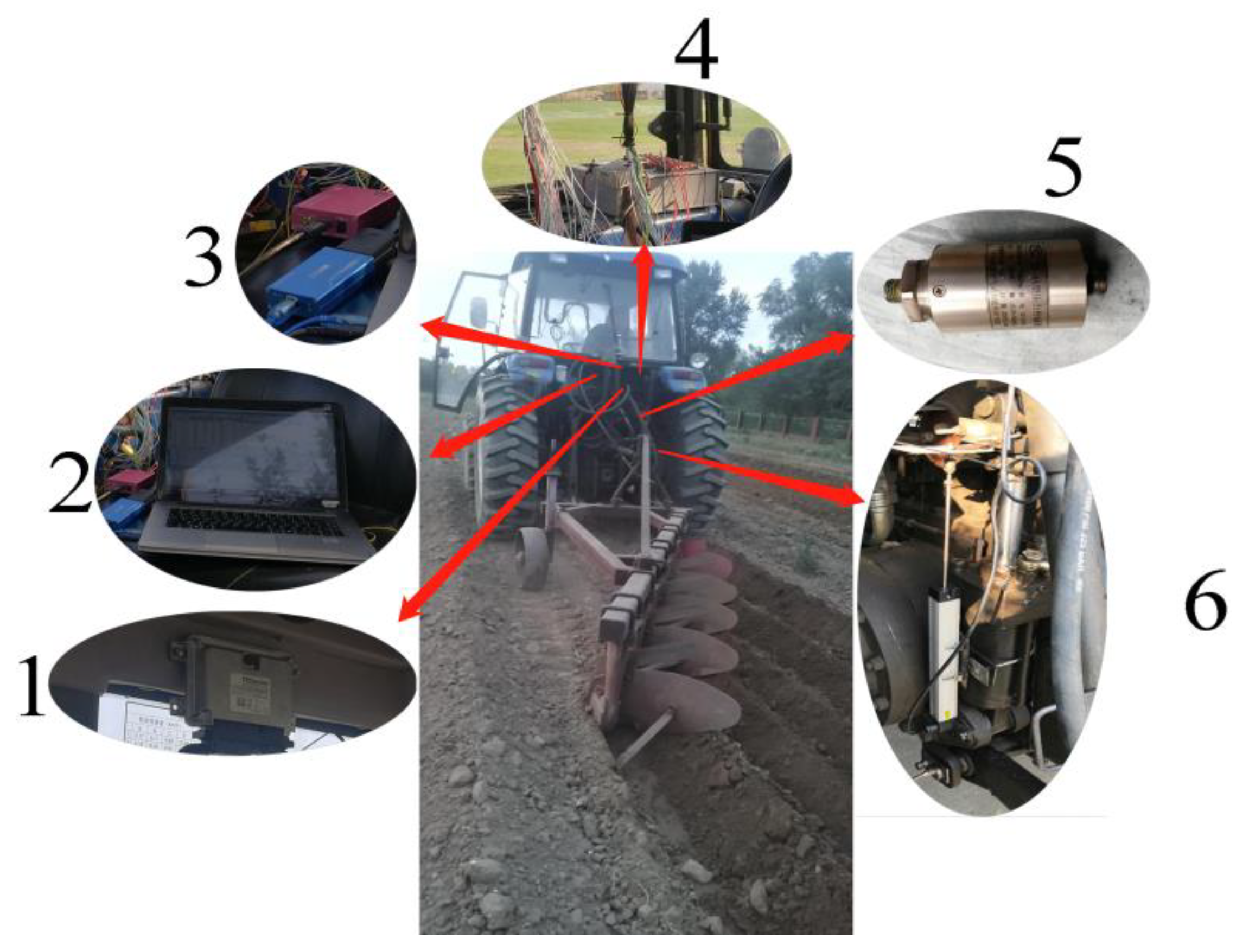
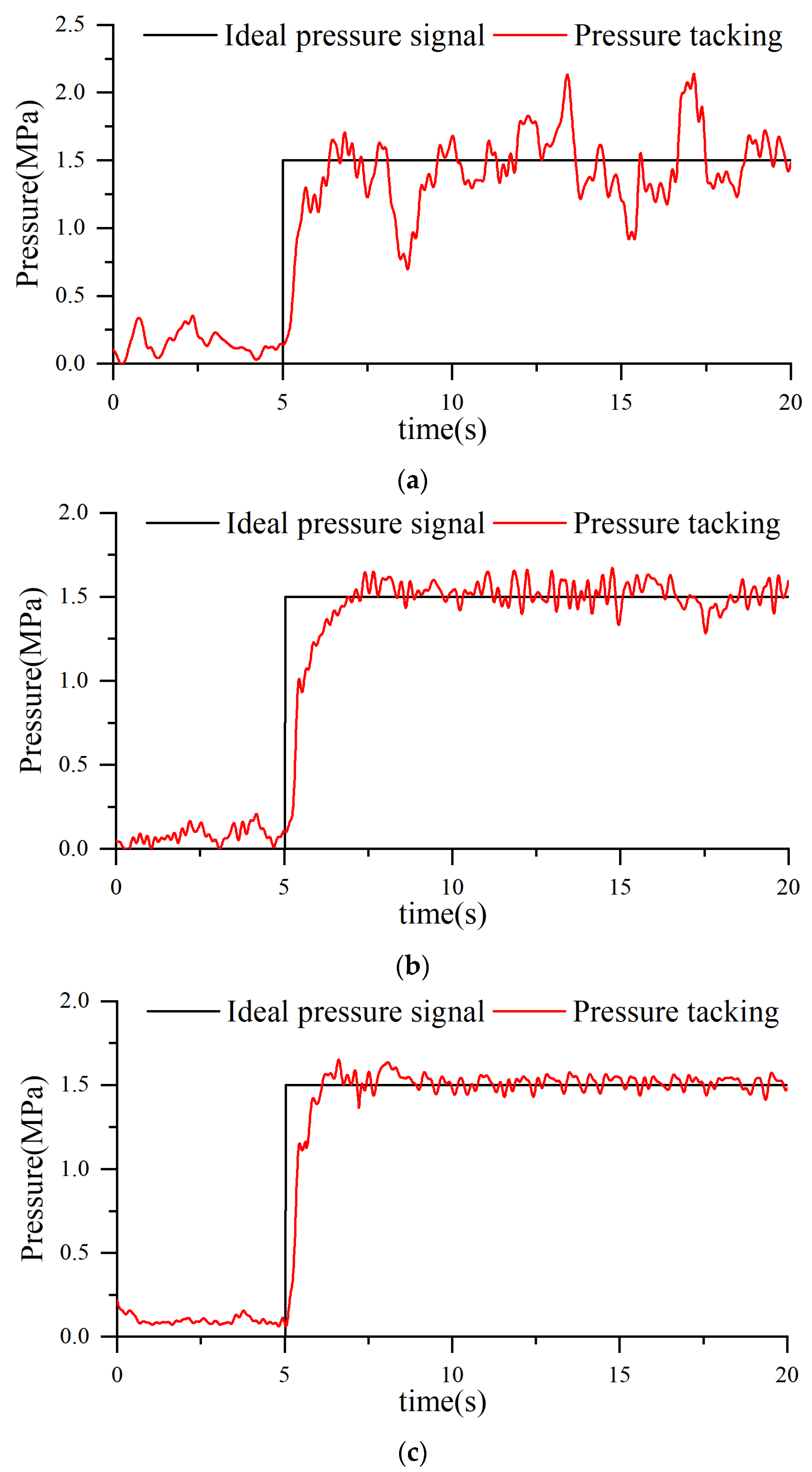
| Variables | Basic Domain | Quantization Domain | Quantization Factor |
|---|---|---|---|
| e | [−1.5 1.5] | {−3,−2,−1,0,1,2,3} | 2 |
| ec | [−15 15] | {−3,−2,−1,0,1,2,3} | 0.2 |
| ∆Kp | [−0.5 0.5] | {−1,2/3,1/3, 0,1/3, 2/3,1} | 2 |
| ∆Ki | [−1 1] | {−1,2/3,1/3, 0,1/3, 2/3,1} | 1 |
| ∆Kd | [−0.02 0.02] | {−1,2/3,1/3, 0,1/3, 2/3,1} | 50 |
| e | ec | ||||||
|---|---|---|---|---|---|---|---|
| NB | NM | NS | Z | PS | PM | PB | |
| NB | PB NB PS | PB NB NS | PM NM NB | PM NM NB | PS NS NB | Z Z NM | Z Z PS |
| NM | PB NB PS | PB NB NS | PM NM NB | PS NS NM | PS NS NM | Z Z NS | NS Z Z |
| NS | PM NB Z | PM NM NS | PM NS NM | PS NS NM | Z Z NS | NS PS NS | NS PS Z |
| Z | PM NM Z | PM NM NS | PS NS NS | Z Z NS | NS PS NS | NM PM NS | NM PM Z |
| PS | PS NM Z | PS NS Z | Z Z Z | NS PS Z | NS PS Z | NM PM Z | NM PB Z |
| PM | PS Z PB | Z Z NS | NS PS PS | NM PS PS | NM PM PS | NM PB PS | NB PB PB |
| PB | Z Z PB | Z Z PM | NM PS PM | NM PM PM | NM PM PS | NB PB PS | NB PB PB |
| Input Signal | Compensation Correction | Controller | Overshoot | Response Time | Stable Time |
|---|---|---|---|---|---|
| 1.5 MPa | No | Traditional PID | instability | 1 s | instability |
| Yes | Traditional PID | 0 | 3.5 s | 3.5 s | |
| Yes | Adaptive Fuzzy PID | 0 | 1 s | 1 s |
| Controller | Response Time | Pressure Range |
|---|---|---|
| Traditional PID | 2 s | 0.7~2.1 MPa |
| Traditional PID with compensation correction | 2.5 s | 1.2~1.7 MPa |
| Adaptive Fuzzy PID with compensation correction | 1.5 s | 1.3~1.6 MPa |
© 2020 by the authors. Licensee MDPI, Basel, Switzerland. This article is an open access article distributed under the terms and conditions of the Creative Commons Attribution (CC BY) license (http://creativecommons.org/licenses/by/4.0/).
Share and Cite
Liu, C.; Zhao, J.; Gu, J.; Du, Y.; Li, Z.; Zhu, Z.; Mao, E. Pressure Control Algorithm Based on Adaptive Fuzzy PID with Compensation Correction for the Tractor Electronic Hydraulic Hitch. Appl. Sci. 2020, 10, 3179. https://doi.org/10.3390/app10093179
Liu C, Zhao J, Gu J, Du Y, Li Z, Zhu Z, Mao E. Pressure Control Algorithm Based on Adaptive Fuzzy PID with Compensation Correction for the Tractor Electronic Hydraulic Hitch. Applied Sciences. 2020; 10(9):3179. https://doi.org/10.3390/app10093179
Chicago/Turabian StyleLiu, Changqing, Jianjun Zhao, Jinheng Gu, Yuefeng Du, Zhen Li, Zhongxiang Zhu, and Enrong Mao. 2020. "Pressure Control Algorithm Based on Adaptive Fuzzy PID with Compensation Correction for the Tractor Electronic Hydraulic Hitch" Applied Sciences 10, no. 9: 3179. https://doi.org/10.3390/app10093179
APA StyleLiu, C., Zhao, J., Gu, J., Du, Y., Li, Z., Zhu, Z., & Mao, E. (2020). Pressure Control Algorithm Based on Adaptive Fuzzy PID with Compensation Correction for the Tractor Electronic Hydraulic Hitch. Applied Sciences, 10(9), 3179. https://doi.org/10.3390/app10093179




